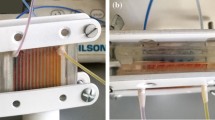Abstract
When uremic blood flows through dialyzers during hemodialysis, dialysis membrane surfaces are exposed to shear stress and internal filtration, which may affect the surface characteristics of the dialysis membranes. In the present study, we evaluated changes in the characteristics of membrane surfaces caused by shear stress and internal filtration using blood substitutes: water purified by reverse osmosis and 6.7 wt% dextran70 solution. We focused on the levels of a hydrophilic modifier, polyvinylpyrrolidone (PVP), on the membrane surface measured by attenuated total reflectance Fourier transform infrared spectroscopy. Experiments involving 4 h dialysis, 0–144 h shear-stress loading, and 4 h dead-end filtration were performed using polyester-polymer alloy (PEPA) and polysulfone (PS) membranes. After the dialysis experiments with accompanying internal filtration, average PVP retention on the PEPA membrane surface was 93.7% in all areas, whereas that on the PS membrane surface was 98.9% in all areas. After the shear-stress loading experiments, PVP retention on the PEPA membrane surface decreased as shear-stress loading time and the magnitude of shear stress increased. However, with the PS membrane, PVP retention scarcely changed. After the dead-end filtration experiments, PVP retention decreased in all areas for both PEPA and PS membranes, but PVP retention on the PEPA membrane surface was lower than that on the PS membrane surface. PVP on the PEPA membrane surface was eluted by both shear stress and internal filtration, while that on the PS membrane surface was eluted only by internal filtration.
Similar content being viewed by others
References
Ostuni E, Grzybowski BA, Mrksich M, Roberts CS, Whitesides GM. Adsorption of proteins to hydrophobic sites on mixed selfassembled monolayers. Langmuir 2003;19:1861–1872
Mitamura Y, Nishida H. Present status and future perspectives of support systems for artificial organs in patients living away from hospital. J Artif Organs 2001;4:169–171
Vanholder R. Biocompatibility issues in hemodialysis. Clin Mater 1992;10:87–133
Liao Z, Klein E, Poh CK, Huang Z, Lu J, Hardy PA, Gao D. Measurement of hollow fiber membrane transport properties in hemodialyzers. J Membr Sci 2005;256:176–183
Sirolli V, Ballone E, Amoroso L, Liberato DL, Mascio RD, Capelli P, Albertazzi A, Bonomini M. Leukocyte adhesion molecules and leukocyte-platelet interactions during hemodialysis: effects of different synthetic membranes. Int J Artif Org 1999;22:536–542
Higuchi A, Shirano K, Harashima M, Yoon OB, Hara M, Hattori M, Imamura K. Chemically modified polysulfone hollow fibers with vinylpyrrolidone having improved blood compatibility. Biomaterials 2002;23:2659–2666
Fukuda M, Miyazaki M, Hiyoshi T, Iwata M, Hongou T. Newly developed biocompatible membrane and effects of its smoother surface on antithrombogenicity. J Appl Polym Sci 1999;72: 1249–1256
Hoenich AN, Stamp S, Roberts JS. A microdomain-structured synthetic high-flux hollow-fiber membrane for renal replacement therapy. ASAIO J 2000;46:70–75
Hayama M, Yamamoto K, Kohori F, Sakai K. How do polysulfone dialysis membranes containing polyvinylpyrrolidone achieve excellent biocompatibility? J Membr Sci 2004;2004:41–49
Wolff SH, Zydney AL. Effect of bleach on the transport characteristics of polysulfone hemodialyzers. J Membr Sci 2004;243: 389–399
Hayama M, Yamamoto K, Kohori F, Uesaka T, Ueno Y, Sugaya H, Itagaki I, Sakai K. Nanoscopic behavior of polyvinylpyrrolidone particles on polysulfone/polyvinylpyrrolidone film. Biomaterials 2004;25:1019–1028
Kobayashi T, Tanaka K. Selectively transmissive polysulfonic hollow fiber membrane. US Patent 1995, No. 5436068
Courtney JM, Lamba NMK, Sundaram S, Forbes CD. Biomaterials for blood-contacting applications. Biomaterials 1994;15:737–744
Matsuo K, Matsuyama R, Inoue M, Fujinaga M, Nakamoto M. Evaluation of hydrophilicity of polysulfone membrane with polyvinylpyrrolidone (PVP) and elution characteristics of PVP. High Performance Membrane’ 05 2005;59:70–76 (in Japanese)
Akiba T, Furukawa N, Sano N, Shibamoto T, Tamura H, Hata T, Tamura T, Marumo F. Methods of rinsing and their effluent from polysulfone hollow-fiber dialyzers. Jpn J Artif Organs 1997;26:126–129 (in Japanese)
Suzuki Y, Fujimoto E, Nagaoka T, Yamada M. Dialysis instruments focused on biocompatibility IV. Biocompatibility evaluation of dialysis membranes by FTIR-ATR. Jpn J Clin Dial 2004;20:535–540 (in Japanese)
Sakai K, Tashiro K, Sakurai H, Kanamori T, Torii M, Ohshima M, Higuchi J, Sakai T. Factors affecting plasma and blood viscosity and corresponding abnormalities in renal failure patients. Chem Eng J 1987;36:B7–B13
Iwashima S, Asano S, Kohori F, Sakai K, Fukuda M, Hiyoshi T. Performance evaluation of high-performance dialyzer by computer simulation study. High Performance Membrane’ 06 2006;61:119–121 (in Japanese)
Uesaka M, Yamada M. Polysulfone hollow-fibers for medical care. Jpn Patent (Tokkaihei) 1994; No. 5:91173
Nakao M, Suzuki H, Chiba T, Yoshida M. Hollow-fibers and their preparation methods. Jpn Patent (Tokkaihei) 1998; No. 10: 118472
Author information
Authors and Affiliations
Corresponding author
Rights and permissions
About this article
Cite this article
Matsuda, M., Sato, M., Sakata, H. et al. Effects of fluid flow on elution of hydrophilic modifier from dialysis membrane surfaces. J Artif Organs 11, 148–155 (2008). https://doi.org/10.1007/s10047-008-0417-4
Received:
Accepted:
Published:
Issue Date:
DOI: https://doi.org/10.1007/s10047-008-0417-4




